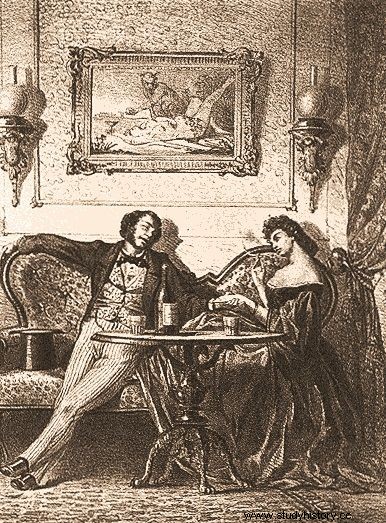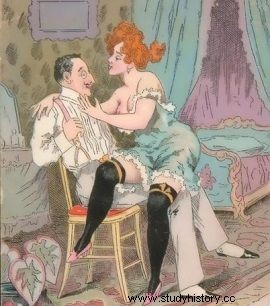A quarter of debauchery in the middle of the Russian capital? Today, something like this would be unthinkable. But in the 19th century, Moscow was neither so prudish, nor was it the capital. And she traded sex ... at the behest of the authorities.
It's a pretty nice neighborhood today. Offices, cafes, beautiful Moscow boulevards. It houses the City Theater and solid merchant houses, and in the vicinity of the famous Sandunów Bans. There is not even a trace of the shadowy district from 200 years ago. At the beginning of the nineteenth century, this part of Moscow was dominated by the suspicious hotel "Crimea", where business was beaten by thieves, gangsters and a whole galaxy of dark star types. The floors in this tabernacle were called "Hell" and "Purgatory" and you can only imagine where it came from.
A whole district of all sorts of fun
The entire quarter - Sretenska Góra - was full of brothels and characteristic octagonal lanterns, hung on yellow, not red, arches. And although in 1866 "Crimea" was turned into a restaurant where a pretty good Hungarian choir performed, the district still enjoyed a bad reputation, and the so-called Maiden-Matryoshkas were catching drunken guys in the neighborhood.

Ladies of light manners were waiting for their customers in quiet rooms.
In the 19th century, paid love was completely legal in Russia. It is true that Catherine the Great wanted to liquidate her and banned brothels, but her son (Paweł I, who was said to be doing everything the other way round than his mother), allowed them to act in the light of the law again.
The official history of Moscow prostitution began in 1844, when the second (after St. Petersburg) medical and police station was established in the city. Every two weeks, each registered woman of good morals was required to appear at a sort of medical commission. These ladies also had to have the so-called yellow books, i.e. "professional" ID cards with a photo.
Though the entire procedure was essentially a superficial view of the delinquent, there were queues in front of the building. Inspectors also visited brothels that financed medical consultations. However, in the event that a longer treatment was required, its costs were to be covered by the state.

"Yellow book", or prostitute ID.
So how much for a night?
In 1889, the supervision of prostitution was taken over by the city pride, and the central venereal clinic was moved closer to the clients, to Poslednj (Last) Alley. The lines are over, but patient assessment methods and primitive treatments have changed little.
The regulations strictly regulated the functioning of brothels. A woman between the ages of 30 and 60 could become a brothel, interestingly enough that she must conduct herself well.
Brothels officially fell into three categories. In the cheapest places, the visit cost 30-50 kopecks (night - two rubles), in economy class - 1.5-2 rubles (night for 3-5 rubles), and in exclusive places, they took 3-5 rubles for a visit and red ring (10 rubles) per night .
Top-class prostitutes, earning even a dozen or so times more for a visit than their friends from the worst brothels, could work much less. In practice, this meant receiving an average of five clients a day (others had up to twenty).
It is best to hire yourself in the exclusive segment
It is easy to calculate that they earned at least 600 rubles of income per month, which was a considerable sum with the cost of living at that time, although ¾ of this amount was taken by the brothel providing food and care for the employees.

To serve some customers, prostitutes needed "anesthesia." This is why many of them spent a large proportion of their earnings on alcohol and drugs.
The girls were losing just as much money. For clothes, cosmetics, but also for alcohol and drugs, often necessary to survive in this supposedly easy and enjoyable job. In fact, prostitutes did not live long, and the peak of their career was being a brothel's right-hand man and taking over the business.
There weren't many exclusive brothels. The most famous is the house called "Rudniowka" in Zaułek Sobolowy at number 13 (now Bolshoi Golovin), where 18 girls worked. There was a so-called Turkish room, furnished with splendor, with walls covered with Turkish carpets and covered with mirrors. The service provided in this room cost as much as 15 rubles. Merchants - Old Believers - took a liking to it. There was an exceptionally hard work for a black prostitute, whose charms enjoyed great interest.
There will also be something for masochists
For just two years, on Pietrowski Boulevard, in the tenement house where the Szampanskogo bar (Champagne Bar) is located, there was another very mysterious place.

Everyone could find something for themselves in Moscow brothels.
Sado-masochists, obviously having the appropriate financial resources, attracted him. It was managed by a certain Emilia Khatuntseva. The most famous room in this building was covered with mirrors, and golden Moscow youth organized it in sexually explicit orgies.
An older erotomaniac came to Moscow on purpose to visit Mrs. Khatuntseva.
Stripped naked in the bedroom of one of the girls, who, together with his friend, dressed only in shirts, each with a huge bunch of rods in her hands, were beating the old man mercilessly on a tender spot until he is satisfied. The old man was screaming and crying every time, but after the screening ended, without batting an eye, he paid each girl 25 rubles.
Clean this whole brothel!
The red light district was no longer tolerable. At the turn of the century, it began to get out of the control of the authorities and, in addition to the heart of paid love, it also became a hotbed of crimes of all kinds.

Gradually, the authorities began to get rid of the tenants of the pleasure houses.
In 1906, permits for brothels were no longer issued in this area, although certificates could still be obtained elsewhere.
Residents protested, fearing "infecting healthy parts" of the city.
The era of classic brothels was ending, and more and more "individual" prostitutes appeared on the streets. Many houses in the area have been demolished, the name of the street has also been changed, and the area has become quiet and peaceful.

After all, the "red light" district in Moscow was just a memory.
The Bolshevik revolution banned prostitution, treating it as yet another element of the oppression of citizens (or rather citizens) by the tsarist regime.
Prostitutes, as victims of the old system, were given priority when applying for a job. By a strange coincidence, there were exceptionally large numbers of former terribly oppressed fallen women…
